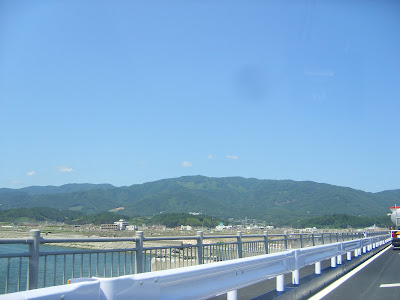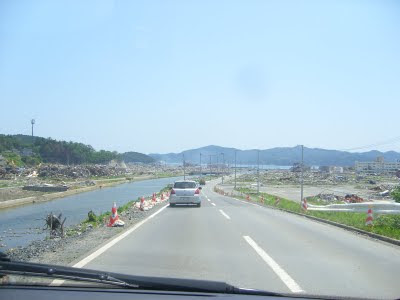




Four months to the day after the March 11th earthquake and tsunami I arrived in the disaster area to volunteer with relief work. After climbing Dewa Sanzan with my friends on the weekend I drove to Sendai Sunday night, then onwards to Ofunato on Monday. As I drove through the Japanese countryside it was a very pleasant summer day to roll down the windows and smell the fresh air. I passed a few towns along the coastline that were pretty idealic Japanese coastal towns. With my music pumping and the sunshine making the world bright I was feeling pretty good. As I approached the coast further on I saw two badly damaged cars in a roadside parking lot and then just a bit later on a 30 foot section of guard rail that had been completely crumpled like a wadded up straw. I thought to myself, wow, that must have been a bad accident and at that moment I crested a hill and Kessenuma (picture 1) was revealed to me.
I quickly realized those cars were not damage from a traffic accident. For some reason it had not been on my mind that I would soon be entering the area and it really was a shock. I had seen many images in the news and watched hours of footage of the tsunami, but nothing prepares you for the real thing. For the first 15 minutes all I saw of Kessenuma was a tangle of debris and piles being built by Caterpillar equipment. into large mounds, like ants building ant hills. Soon I mounted another hill and there were houses and businesses standing intact. This pattern came again and again as I made my way north along the coast going to Ofunato. On one side of a hill there was nothing but destruction, on the other side of a hill, normal residential streets. The most dramatic of all being in Rikuzentakata where more than 80% of structures were destroyed, essentially it was been “wiped from the map”(picture 2).
After arriving in Ofunato (picture 3) and finding the All Hands base
Project Tohoku from All Hands Volunteers on Vimeo.
I got settled in and to work. Over the next week I helped various crews with digging ditches in rice fields, clearing water drainage tunnels, scrubbing tubs and stoking fires and an evacuation center, cleaning and restoring damaged photographs, and translating between crew leaders and Japanese volunteers. Each of these had their own rewards.
Each night at dinner a meeting would take place in which new people introduced themselves, leaving people said their goodbyes, and workers would sign up for crews for the next days work. On that first night a woman who had been there for some time got up to say her goodbyes. It was a tearful speech in part because she had come to love the work she was doing, but also because of the connection she felt with the people of Ofunato. She said that of all the things she wanted to emphasize it was making a connection to the people of Ofunato that was most important in her time there an in ours. In her speech she mentioned how someone had explained to her that fireflies are believed to carry the spirits of the dead and that one of her most emotional moments for her was seeing some at night by the river.
Since it was my first night there and there wasn't much going on after the meeting ended I went to the local convenience store to get some snacks and walk about the neighborhood, but I noticed that the sunset was particularly beautiful as I was crossing the river. I got my snacks and a beer and sat by the river banks watching the sun go down, thinking about what the week ahead would be like. As dark came on fireflies began to float about and I couldn’t help but recall that each of them would be carrying a spirit.
My first day in the field I dug ditches in Rikuzentakata and it was hard dirty work. Digging through 3 ft deep mud and debris we would often hit objects with our shovel and each time I had to wonder what we would be digging up. We found cassettes, cuff links, clothing, tires, rice cookers, sign posts, and a host of other things. Each time I found a new object I wondered who it belonged to.
Another day I worked at cleaning photographs and each one I cleaned I looked at the smiling faces and wondered. Wedding albums, school trips, family portraits, who was still among us? Will these photos ever be claimed?
One day I worked at the evacuation center scrubbing tubs and stoking a fire that would heat the water. It was an all day job and very hot having to be near the fire. In some ways I felt like the job was not as interesting as the other jobs I had done, but it was rewarding. As we were preparing to leave for the day a single old woman came from the shelter and said something like, “It’s so hot today! Thank you for heating the water”, as she made her way to the bath, the first person to use it that day. That was enough to make it worth it, but many other people came forward to thank us for our work. Old women brought snacks and tea, people thanked us and waved from passing cars, many other Japanese volunteers shook our hands and I even got one hug which is fairly unusual for a Japanese person.
On my final day I worked with a road crew cleaning out water tunnels and clearing debris from roads and sidewalks. Shortly after arriving a bus load of Japanese volunteers pulled up and started doing the same work a little further on up the street. My crew leader then told me to go work with them since I could speak Japanese. I learned that they had come all the way from Shikoku, about 1000km away. Most of the rest of the day I spent with them joking around and getting dirty. It was nice to make that connection, to tell them who we were and why we were there, but also to be able to serve as a bridge between my team leader and their team leader so they could share ideas and work together. At the end of the day as the Japanese group was leaving they started to call my name (Kebin!Kebin!shashin!) and we came together for a group photo (4).
I'll be forever grateful that my team leader put me with the Japanese crew that day as it is something I will never forget. The reason that my team leader knew I spoke Japanese was because the night before there had been a festival on the street where our base was located. As the night wore on some of the volunteers made our way to a local person’s house who had invited us in for more food and drink. I talked to a number of Japanese people and at one point made my way into a conversation that was happening between a Japanese woman and the team leader where they were struggling a bit to communicate with each other. I got to tell him that she was expressing how touched she was by our hard work and he returning thanks for having us over. It’s those connections, as the woman said on the first night, that matter most. I believe it’s those connects which brought many people like myself to aid Japan in the first place and why All Hands exists. My experience with All Hands was a positive one and I owe a debt of thanks to them for helping me to get in there and get my hands dirty while making the process of actually doing it as painless as possible.
In the early evening on Friday I packed up my bags and started to drive out of Ofunato to meet my father in law in Minami-soma. Unfortunately there would be no tearful last dinner speech from me, but I shook a few hands and was out the door. In Minami-soma I would spend one more day volunteering with my dad, cleaning and drying photographs. As I drove out of town I spotted a sign on a building (photo 5). It reads, “Disaster comes when you forget.” Then there is a line marking the height of the wave that came to Ofunato from an earthquake that occurred in Chile, but sent waves to Ofunato. If you take a look at the building you can see that the damage from this most recent tsunami is more than twice that height.
You see, this is not the first time that Ofunato has been hit by a tsunami in recent history, not even the second if you go back a bit further. This is the third time that the town has been hit and destroyed. While working at cutting wood and stoking the first at the shelter I found an old stone in a park with the warning inscribed about tsunamis. The year was too old to be the latest or even the second most recent wave. The inscription was more than 100 years old, telling people to be aware of the waves from the ocean. Yet the people pick up and start over again.











